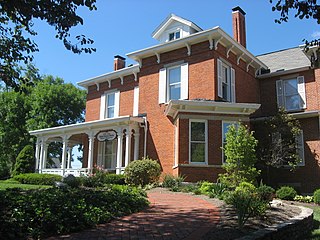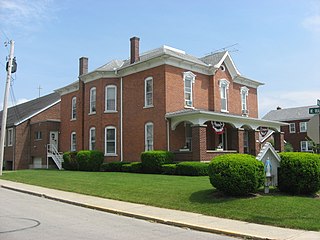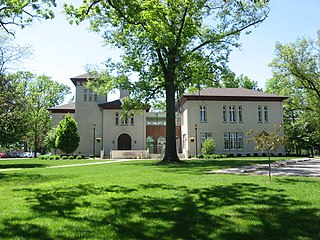
The Old South Meeting House is a historic Congregational church building located at the corner of Milk and Washington Streets in the Downtown Crossing area of Boston, Massachusetts, built in 1729. It gained fame as the organizing point for the Boston Tea Party on December 16, 1773. Five thousand or more colonists gathered at the Meeting House, the largest building in Boston at the time.

Urbana University was a private university specializing in liberal arts education and located in Urbana, Ohio. In its final few years, it was purchased by Franklin University and was a branch campus of that university.

Baldwin Wallace University (BW) is a private university in Berea, Ohio. Established in 1845 as Baldwin Institute by Methodist businessman John Baldwin, it merged with nearby German Wallace College in 1913 to become Baldwin-Wallace College.

The Belmont–Paul Women's Equality National Monument is a historic house and museum of the U.S. women's suffrage and equal rights movements located in the Capitol Hill neighborhood of Washington, D.C. The monument is named after suffragists and National Woman's Party leaders Alva Belmont and Alice Paul.

The Henry Maltby House was a historic house near the campus of Miami University in Oxford, Ohio, United States. Built in the 1850s, it was once home to a prominent minister in the community. Important partly for its architecture, it was eventually relegated to student housing before being demolished. Before its destruction, it was named a historic site.

Prospect House, known also as just Prospect, is a historic house on the Princeton University campus in Princeton, Mercer County, New Jersey, United States. Built in 1851, it is a fine example of the work of architect John Notman who helped popularize Italianate architecture in America. Notable residents include Woodrow Wilson during his tenure as president of the university. The building now serves as a faculty club. It was designated a National Historic Landmark in 1985 for its architecture and historic associations.

The William Lawrence House is a historic house in Bellefontaine, Ohio, United States. Located along Main Street north of the city's downtown, it is historically significant as the home of William Lawrence, a prominent U.S. Representative during the late nineteenth century.

The Church of Our Saviour is a historic Episcopal parish in the village of Mechanicsburg, Ohio, United States. Founded in the 1890s, it is one of the youngest congregations in the village, but its Gothic Revival-style church building that was constructed soon after the parish's creation has been named a historic site.

Second Baptist Church is a historic church building in the village of Mechanicsburg, Ohio, United States. Constructed in the mid-19th century, it is the oldest church in the village, and it has been named a historic site.

St. Michael's Catholic Church is a historic Catholic church in Mechanicsburg, a village in Champaign County, Ohio, United States. Completed in the 1880s, it served a group of Catholics who had already been meeting together for nearly thirty years. One of several historic churches in the village, it has been designated a historic site because of its well-preserved nineteenth-century architecture.

St. Paul's African Methodist Episcopal Church is a historic church in Urbana, Ohio, United States. Built in the Greek Revival style in 1876, it is home to a congregation that was founded in the mid-1820s.
Richards House may refer to:

The John Q.A. Ward House is a historic house in Urbana, Ohio, United States. Located along College Street on the city's western side, it was built in 1820 by Colonel William Ward, the founder of Urbana, as a wedding present for his son, John Anderson Ward. John lived in the house until his death in 1855.

Immaculate Conception Catholic Church is a Roman Catholic parish in Botkins, Ohio, United States. Erected in 1865, the parish owns a complex of buildings constructed in a wide range of years, including two that have been designated as historic sites.

Precious Blood Catholic Church is a Roman Catholic parish in Chickasaw, Ohio, United States. Erected in 1903 and still an active parish, the church historically owned two buildings constructed in its early years that have been designated as historic sites.

St. Sebastian's Catholic Church is a historic Roman Catholic church in Marion Township, Mercer County, Ohio, United States. Located in the unincorporated community of Sebastian, it is the home of an active congregation and has been declared a historic site because of its well-preserved early twentieth-century Gothic Revival architecture.

The Urbana College Historic Buildings are a historic district on the campus of Urbana University in Urbana, Ohio, United States. Composed of three nineteenth-century buildings, the district includes the oldest structures on the university's campus.

The history of Baldwin Wallace University dates back to 1828, when co-founder John Baldwin settled in present-day Berea, Ohio. His founding eventually established Baldwin–Wallace College. This founding of present-day Baldwin Wallace University began when Baldwin Institute was established in 1845. With the help of James Wallace, Baldwin Institute began offering college courses. Eventually, in 1863, a resolution established a separate school from Baldwin University to serve the booming local German population called German Wallace College. Originally part of Baldwin Institute, German Wallace College was established just down the road. As a result of financial hardships the schools merged in 1913, forming Baldwin-Wallace College. In 2010, several buildings were added to the National Register of Historic Places combining the former Lyceum Village Square and German Wallace College to form the BW South Campus Historic District. In 2012, Baldwin-Wallace College became Baldwin Wallace University and established the BW North Campus Historic District. The Conservatory is home to the Baldwin-Wallace Bach Festival, the oldest collegiate Bach Festival and the second-oldest Bach festival in the United States honoring Johann Sebastian Bach.

The Edward Sewall Garrison is a historic house at 16 Epping Road in Exeter, New Hampshire. With a construction history dating to 1676, it is one of New Hampshire's oldest buildings, and is a rare example of a formerly fortified garrison house in its original location. The house was listed on the National Register of Historic Places in 1980.

The English Building, previously known as the Woman's Building and Bevier Hall, is a historic structure on the campus of the University of Illinois Urbana-Champaign. It is located on the west side of the Main Quad between Lincoln Hall and the Henry Administration Building. The original portion of the English Building, designed by McKim, Mead & White, was completed in 1905 and subsequently expanded in 1913 and 1924. The distinctive columned front, which faces the Main Quad, dates to the 1913 addition. Since 1956, the English Building has been home to the university's Department of English.






















